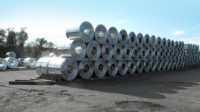Delegated design has been around for quite some time and is a well-established practice that is becoming increasingly popular as building systems become more complex and require specialized details. During delegated design, architects pass design responsibilities to the contractor, which is quite often a requirement built into a project’s specifications.
The International Building Code permits the architect of record to delegate design to the contractor, but this responsibility is then transferred to the general contractor, who then has the responsibility to allocate the workload to the appropriate subcontractor. For cold-formed metal framing, this typically involves the drywall contractor, carpenter, or framer.
A structural engineer of record is responsible for the design of those elements included in his or her contract. The design of some elements may be “delegated” to a specialty structural engineer. The engineer of record should review the specialty structural engineer’s work associated with those items to the degree necessary to support the structural engineer of record’s contractual responsibilities.
As certain projects move away from traditional delivery methods such as design-bid-build to design-build and public-private partnerships, whole projects essentially move towards delegated design, ultimately making the general contractor the owner of the design work.
Similarly, the primary responsibility for project specifications usually rests with the project architect, but the development of specifications for structural systems (including cold-formed steel framing) is often delegated to the structural engineer. At the same time, structural engineers usually have at least some information on cold-formed steel framing in their structural general notes.
From the outside, Delegated Design can sometimes seem like an extremely complex relationship between the design professional, contractors, and specialty designers/engineers. With Integrated Project Delivery, Public-Private Partnerships and BIM on the rise, building product manufacturers embrace shared design responsibilities, becoming part of the project early on.
What are Shop Drawings?
Shop drawings can be defined as drawings, figures, schedules and detailed diagrams prepared specifically by a building product manufacturer or supplier to illustrate a part of a project. A subcontractor or contractor will utilize submittals, which include shop drawings, to convey what intends to be constructed. This is an aspect of the building process that is then “delegated” to the contractor, who coordinates the development of specialized engineering documents.
Professional Engineering shop drawing support from a product manufacturer, such as the case with cold-formed metal framing, is how a contractor demonstrates constructability. Where an architectural drawing set may not include system specific details, shop drawings will provide all of the detailing and information required by the contractor to accurately complete installation.
Because neither engineer nor architect can possibly design every single project detail, the design of certain specialty systems are delegated to the contractor, which allows those with more system-specific knowledge and greater expertise to design components and connections that are unique to the system and to the project in the form of shop drawings. Shop drawings, however, are not contract documents. Instead, Shop Drawings demonstrate the way a contractor proposes to meet the design intent for those portions of the work for which the contract documents require submittals. Shop drawings are a necessary component of construction.
As a contractor, how am I supposed to bid a project if the architect has not detailed drawings to include sized members?
When an architect specifies criteria, the contractor is often asked to provide the detailed design. Most cold-formed steel engineers, whether employed by the CFS manufacturer or a third-party specialty engineer, will perform a preliminary design for no fee. This is usually subject to the material of the requested manufacturer and the design of the specialty engineer being used on the project.
Project Tips
Here are Some Tips When Deferring Specialized Structural Design of a Project:
Review the architectural specifications.
The specifications or structural general notes should clearly state the requirements for shop drawings under a professional engineer seal.
Know who is responsible for what.
The specialty structural engineer producing shop drawings is not responsible for any means and or methods of construction, unless they are specifically hired to design construction systems such as temporary bracing or scaffolding or shoring. The structural submittals should include information on any special requirements for installation of the designed materials.
Always seek clarification.
When providing specialty structural engineering services, The Specialty Structural Engineer (SSE) should review the contract documents to determine the design criteria, intent, and applicable codes and standards. If the design intent is not understood, the SSE should request definition or clarification of the design intent from the engineer of record or the architect.
Refer to the Contract Documents.
Items that are required by contract documents to be submitted by the contractor might include shop drawings, fabrication drawings, test reports, product data, schedules, etc. Submittals are not a part of the contract documents but are a work effort requirement of the contract documents.
Reference the Code of Standard Practice.
The American Iron and Steel Institute has published a series of standards to facilitate CFS construction. AISI S202 is the Code of Standard Practice for Cold-Formed Steel Structural Framing. Although not referenced directly by the building code, it gives guidance to all members of the design and construction team on how field and design issues are typically handled, when not specifically addressed in contract documents.
Specifiers are encouraged to reference AISI S202 in their contract documents. Section A4, entitled “Responsibility for Design,” provides information and commentary on how the design team and the SSE coordinates their work. Another useful reference is the Council of American Structural Engineers document on delegated design. This document is a resource for contractors, and both engineers and specifiers should comply with it. Note that in the state of Florida, delegated design is a defined legal term.









Report Abusive Comment